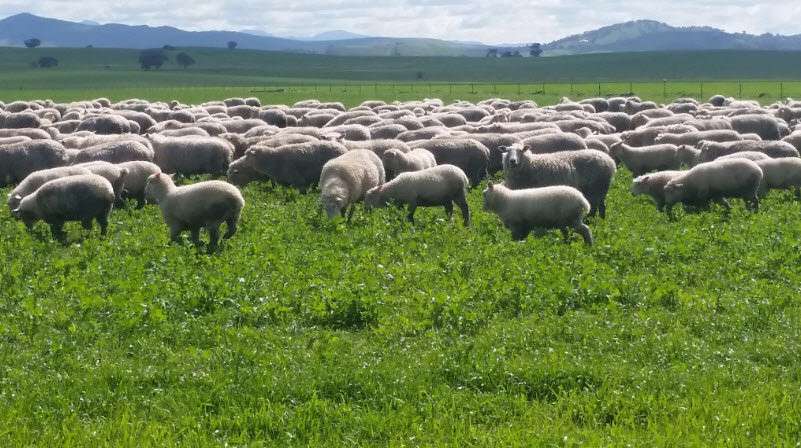Spring & summer planted forage & fodder crops
By Robert Winter

Spring and summer present an opportunity to plant a forage crop for summer, autumn or winter feed. Depending on the environment, planting time, stock needs, climate and water availability, there is a range of productive varieties available. Fodder crops provide valuable feed, they are also an excellent way to provide a potential cropping break or as a handy and valuable 'catch-crop' over summer between winter crops.
Some of the benefits of summer forage crops include:
- Feed at key times when pastures are of low quality or quantity
- High yield on a small area: takes pressure off other grazing areas of the farm
- Efficient use of irrigation water: high WUE compared to grass pastures or lucerne
- Weed, disease or pest break.
- High quality feed: animal performance
- Home-grown feed at low cost.
Forage brassicas are often used to provide high quality, in-situ green feed. There are a range of options from leafy turnips for quick feed, high yielding rapes, summer turnips and longer season 'keeper turnips, swedes and kale to grow and reserve for late autumn and winter feed. Most brassicas may be sown in Tasmania with success from late October through to early February, and provide a low-cost and highly reliable feed source.
Sub-tropical grasses may be useful in circumstances where some flexibility to either graze or make fodder is required. This group includes millet, forage sorghum and forage or silage maize. The sowing window for these is relatively short (Nov-Dec) as they require a higher soil temperature and are frost sensitive, thus curtailing their length of potential growing season. Millet sorghum and maize have high yield potential and can provide a good bulk of feed, hay or silage through summer and early autumn.
Chicory is another beneficial inclusion, either as a sole stand or in combination with brassicas, clovers or millet. To obtain the best results with chicory, it should be sown around September-early October. It provides very high quality feed with few insect pests or animal management concerns and may also be taken for silage – hay may be problematic as it has low fibre content and may not bale well.
There is also developing recognition in Tasmania of the potential for vetch as a spring planted hay and silage option. Vetch has been successfully grown from September- early November planting in mild summer areas either as a sole stand or in combination with spring cereals. The resultant crop is harvested in summer, most usually as silage, with enthusiastic acceptance by many dairy farmers in particular.
Paddock Preperation & Sowing
In existing pastures, tillage or spray fallowing should be carried out at least 4 - 6 weeks prior to sowing to control weeds and conserve soil moisture. Initial tillage will encourage a strike of weeds. Further cultivation or chemical control will help ensure weed problems are reduced. Alternatively, where a crop is being considered following a spring harvested crops such as cereal silage or peas, direct-drill (no-till) methods are often successful and allow for timelier establishment. Take care with any residual herbicide issues from the previous crop however.
To ensure maximum germination, sow brassicas and chicory no deeper than approximately 1.5cm into a firm, moist seedbed. Millet or vetch should be sown at 2 - 3cm, sorghum and maize may be sown at 4 - 6cm which is useful for chasing moisture on heavier soils. Pre-watering may be extremely beneficial, and a good option if using water sourced from a cold, deep dam. Light rolling and/or a light harrowing can be used to aid seed soil contact and encourage better germination provided the soil surface is not likely to crust. An even and quick germination is often the key to success, especially when managing weeds.
Grazing Management
Sound grazing management of forage crops is essential to maximise yield, feed quality and utilisation. Strip grazing or small block grazing with an electric fence will allow the crop to be utilised more effectively. Losses caused by trampling can be kept to a minimum, gorging can to some degree be managed and by controlling stock movements, the paddock can be utilised effectively. Back-fencing of multiple-graze crops, together with fertiliser top-dressing and timely irrigation will maximise the potential of the paddock.
Avoid introducing empty, hungry animals onto a lush crop as various illnesses may result. Stock should have access to good clean water. This is especially important over summer when evaporation rates are higher and will help prevent suppression of appetite and consequent production setbacks. It’s advisable to introduce animals onto a forage crop slowly at first, so that the rumen can adjust to the change to a high quality diet.
Brassicas are highly digestible and have a low fibre content, so access to roughage such as hay or a run-off to dry pasture may provide a more balanced diet and improved performance. Leafy millet and sorghum offer a reasonably well balanced feed, but become fibrous and lower in energy and protein as they mature later in the season.

